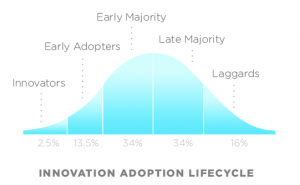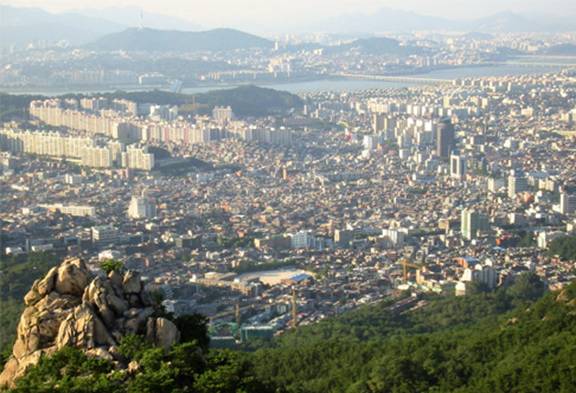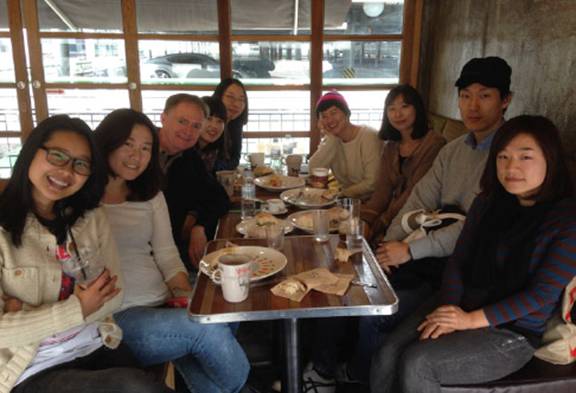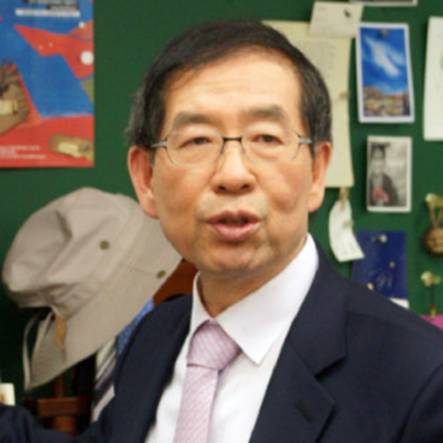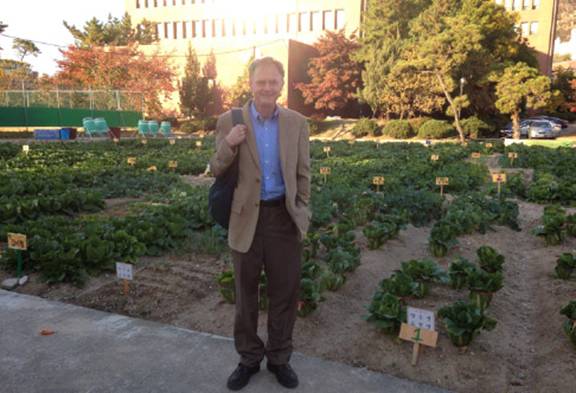MuseLetter #258 / November 2013 by Richard Heinberg
Download printable PDF version here (PDF, 299 KB)
How do we effectively communicate an important but difficult message, even as it appears to fall on deaf ears? The first essay in this month’s Museletter addresses this thorny issue, one which I face every day in my work here at PCI, and which will be familiar to many of you. The second essay is a reminder that in some places the message is getting through and that change does happen. I hope that you will find some hope in my report from a recent visit to Seoul, Korea.
The Climate-PR Puzzle
If we hope to avert climate apocalypse in the decades ahead, we must make fundamental changes to industrial society. Before those changes can be approved and implemented, citizens and policy makers must first come to understand they are essential to our survival. Public relations—the management of the spread of information between an individual or organization and the public—will be an unavoidably necessary tool in the process.
But a PR message capable of persuading policy makers and citizens to end society’s environmental rampage remains elusive. In this essay I hope to explore why an effective PR message is so hard to formulate, and how the whole project might be reconsidered.
Let’s start with what needs to be conveyed. After years of research and thought, I would summarize our dilemma with three general conclusions:
1. Energy is the biggest single issue facing us as a species.*
Global warming—by far the worst environmental challenge humans have ever confronted—results from our current fossil-fuel energy regime, and averting catastrophic climate change will require us to end our reliance on coal, oil, and natural gas. Ocean acidification is also a consequence of burning fossil fuels, and most other environmental crises (like nitrogen runoff pollution and most air pollution) can be traced to the same source.
Therefore ending our addiction to fossil fuels is essential if we want future generations of humans (and countless other species) to inherit a habitable a planet. But these energy sources are “unsustainable” also in a more basic, economic sense of the term: oil, gas, and coal are depleting, non-renewable resources. Already, depletion of the easy-and-cheap sources of petroleum that drove economic growth in the 20th century has led to persistently high oil prices, which are a drag on the economy. We have picked the low-hanging fruit of the world’s petroleum resources, and as time goes on all sources of fossil energy will become more financially costly and environmentally risky to extract. This is a big problem because the economy is 100 percent dependent on energy. With lots of cheap energy, problems of all kinds are easy to solve (running out of fresh water? Just build a desalination plant!); when energy becomes expensive and hard to get, problems multiply and converge.
One way or another, whether our concern is the environment or economic growth, it’s mostly about energy.
_________________
*Arguably, overpopulation is as big an issue as our energy-climate conundrum. I’ve chosen not to focus on it here merely to streamline the narrative. There are many feedbacks between population, energy, and climate, and these deserve discussion elsewhere.
2. We are headed toward a (nearly) all-renewable-energy economy one way or the other, and planning is essential if we want to get there in one piece.
If society is to avoid civilization-threatening levels of climate change, the use of fossil fuels will have to be reduced proactively by 80-90 percent by 2050.
At the same time, despite the claims of abundance of unconventional fuels (shale gas, tight oil, tar sands) by the fossil fuel industry, evidence overwhelmingly shows that drillers are investing increasing effort to achieve diminishing returns.
Either way, fossil fuels are on their way out.
Most nations have concluded that nuclear is too costly and risky, and supplies of uranium are limited.
That leaves renewable energy sources—solar, wind, hydro, geothermal, tidal, and wave power—to power the economy of the future.
3. In the process of transition, the ways that society uses energy must change at least as much as the ways society produces energy.
Every energy source possesses a unique set of characteristics: some sources are more portable than others, or more concentrated, intermittent, scalable, diffuse, renewable, environmentally risky, or financially costly. We have built our current economy to take advantage of the special properties of fossil fuels. The renewable energy sources that are available to replace oil, gas, and coal have very different characteristics and will therefore tend to support a different kind of economy—one that is less mobile, more rooted in place; less globalized, more localized; less when-we-want-it, more when-it’s-available; less engineered, more organic.
At the same time, the sheer quantity of energy that will be available during the transition from fossil to renewable sources is in doubt. While ever-more-rapid rates of extraction of fossil fuels powered a growing economy during the 20th century, society will struggle to maintain current levels of total energy production in the 21st, let alone grow it to meet projected demand. Indeed, there are credible scenarios in which available energy could decline significantly. And we will have to invest a lot of the fossil energy we do have in building post-fossil energy infrastructure. Energy efficiency can help along the way, but only marginally.
The global economy will almost certainly stagnate or contract accordingly.
There it is. It is a complicated message. I’ve just conveyed it in 661 words punctuated by three short summary sentences (here’s a summation of the summation: it’s all about energy; renewables are the future; growth is over.) However, only readers with a lot of prior knowledge will be able to truly understand some of these words and phrases. And many people who are capable of making sense of what I’ve written would disagree with, or dismiss, much of it. The message faces a tough audience, and it flies against deep-seated interests.
Many economists and politicians don’t buy the assertion that energy is at the core of our species-wide survival challenge. They think the game of human success-or-failure revolves around money, military power, or technological advancement. If we toggle prices, taxes, and interest rates; maintain proper trade rules; invest in technology R&D; and discourage military challenges to the current international order, then growth can continue indefinitely and everything will be fine. Climate change and resource depletion are peripheral problems that can be dealt with through pricing mechanisms or regulations.
Fossil fuel companies may understand the importance of energy, but they have a powerful incentive to avoid acceptance of the message that “renewables are the future.” If humanity is headed toward an all-renewable energy economy, then their business has no future. The industry’s strategy for diverting the general public’s buy-in to conclusion 2 is to claim that there is plenty of oil, gas, and coal available to fuel society for decades to come.
Some policy wonks buy “it’s all about energy,” but are jittery about “renewables are the future” and won’t go anywhere near “growth is over.” A few of these folks like to think of themselves as environmentalists (sometimes calling themselves “bright green”)—including the Breakthrough Institute and writers like Stewart Brand and Mark Lynas. A majority of government officials are effectively in the same camp, viewing nuclear power, natural gas, carbon capture and storage (“clean coal”), and further technological innovation as pathways to the solution of the climate crisis without any need for curtailment of economic growth.
Other environment-friendly folks buy “it’s all about energy” and “renewables are the future,” but still remain allergic to the notion that “growth is over.” They say we can transition to 100 percent renewable power with no sacrifice in terms of economic growth, comfort, or convenience. Stanford professor Mark Jacobson and Amory Lovins of Rocky Mountain Institute are leaders of this chorus. Theirs is a reassuring message, but if it doesn’t happen to be factually true (and there are many energy experts who argue persuasively that it isn’t), then it’s of limited helpfulness because it fails to recommend the kinds or degrees of change in energy usage that are essential to a successful transition.
The general public tends to listen to one or another of these groups, all of which agree that the climate and energy challenge of the 21st century can be met without sacrificing economic growth. This widespread aversion to the “growth is over” conclusion is entirely understandable: during the last century, the economies of industrial nations were engineered to require continual growth in order to produce jobs, returns on investments, and increasing tax revenues to fund government services. Conclusion 3, which questions whether growth can continue, is therefore deeply subversive. Nearly everyone has an incentive to ignore or avoid it. It’s not only objectionable to economic conservatives, it is abhorrent to many progressives who believe economies must continue to grow so that the “under-developed” world can improve standards of living.
But ignoring uncomfortable facts seldom makes them go away. Often it just makes matters worse. Back in the 1970s, when environmental limits were first becoming apparent, catastrophe could have been averted with only a relatively small course correction—a gradual tapering of growth and a slow decline in fossil fuel reliance. Now, only a “cold turkey” approach will suffice. If a critical majority of people couldn’t be persuaded then of the need for a gentle course correction, can they now be talked into undertaking deliberate change on a scale and at a speed that might be nearly as traumatic as the climate collision we’re trying to avoid?
To be sure, there are those who do accept the message that “growth is over”: most are hard-core environmentalists or energy experts. But this is a tiny and poorly organized demographic. If public relations consists of the management of information flowing from an organization to the public, then it surely helps to start with an organization wealthy enough to be able to afford to mount a serious public relations campaign.
This is all quite discouraging, to the point that a fourth conclusion seems justified:
4. Managerial elites will not be persuaded of all three previous conclusions until it is too late to organize a proactive energy transition capable of sustaining the current basic structures of industrial society.
It may be that our inability to voluntarily overcome our reliance on fossil fuels is hard-wired into our DNA. Coal, oil, and gas have offered humanity a temporary but enormous energy subsidy. All animals and plants deal with temporary energy subsidies in basically the same way: the pattern is easily visible in the behavior of songbirds visiting the feeder outside my office window. They eat the seed I’ve provided them until the feeder is empty. They don’t save some for later or discuss the possible impacts of their current rate of consumption. Yes, we humans have language and therefore the theoretical ability to comprehend the likely results of our current collective behavior and alter it accordingly. We exercise this ability in small ways, where the costs of behavior change are relatively trivial—enacting safety standards for new automobiles, for example. But where the costs of behavior change might include a significant loss of competitive advantage or an end to economic growth, we tend to act like finches.
Does this mean that society is headed for sudden and utter ruin, that there is nothing we can do to improve our prospects, and that there is absolutely no point in attempting to use public relations to persuade a broad audience of the need for behavior change?
Hardly. As Dmitry Orlov explains in his book The Five Stages of Collapse, there are degrees of disorder that can unfold as societies hit the wall. The five stages he identifies are:
1. Financial collapse
2. Commercial collapse
3. Political collapse
4. Social collapse
5. Cultural collapse
In a recent essay he adds a sixth stage, ecological collapse. His book (and essay) are worth reading in full, but the take-away is simple: if you see that the society around you is approaching a period of disintegrative change, do whatever is necessary to stop the process before it reaches stages 4, 5, or (heaven forbid) 6.
Partial success in societal adaptation is better than none at all. Something similar may be true with regard to our public relations efforts: messages underscoring “it’s all about energy” and “renewables are the future” are marginally helpful in moving society and its leaders toward greater understanding—even if they fail to point to the inevitability of reductions in energy availability and the realization that “growth is over.”
Now add a time dimension. As Everett Rogers pointed out in his book Diffusion of Innovations, new ideas and technologies are adopted in stages: first come the innovators, then early adopters. An early majority heralds more widespread acceptance, which spreads even further with the late majority. At the far end of the bell curve come laggards, who resist innovation the longest. While today only a tiny portion of the population accepts that “growth is over,” perhaps time and circumstances will change that. Some recent shifts in social values and opinions (such as public acceptance of gay marriage) have moved from an “early adopter” to “early majority” phase surprisingly rapidly; perhaps energy and climate awareness will likewise eventually overcome what currently appears to be overwhelming resistance.
Another source of inspiration is Donella Meadows’s perennially useful paper “Leverage Points: Places to Intervene in a System.” Meadows identified twelve leverage points (from constants and parameters, to mindsets and paradigms, to the power to transcend paradigms), which she organized into a hierarchy of relative effectiveness. If we need to change our energy and economic systems profoundly and quickly, we should intervene at the level of paradigms, not regulations and taxes.
Innovators have already teased out the implications of Meadows’s paper and acted on them. What’s needed, evidently, is an attractive new paradigm that might lead us in the direction of proactive reduction in energy consumption. The voluntary simplicity movement blazed that trail back in the 1980s, and the Transition Network has made considerably more headway by organizing whole communities around the task of reducing fossil fuel consumption while relearning pre-industrial skills and rebuilding local economies.
Transition also emphasizes building community resilience as an essential strategy in adapting to our emerging energy, economy, and climate reality. This is because (for reasons discussed in the first portion of this essay) we’ve waited far too long to begin the paradigm shift, and therefore it may not be possible to sustain many of the systems that currently support an industrial mode of societal organization. Shocks are on the way, and we need to bounce rather than shatter.
It’s easy to see how elected leaders could help in this vital transformation if they were inclined to do so—for example, by ditching GDP in favor of Genuine Progress Indicator (GPI) or Gross National Happiness (GNH). But most policy makers are likely to remain in the “late majority” or even “laggard” categories. (For more suggestions to electeds, see this “top 10” list compiled by Herman Daly.)
If, like me, you’re an innovator or early adopter, there are lots of reasons to feel apprehensive these days. But there is too much at stake to indulge in the luxury of cynicism. Our job is to keep coming up with convincing, well-reasoned, and well-documented arguments for change; attractive PR messages; a compelling new paradigm; and impressive demonstration projects—while opposing further fossil fuel extraction, new roads, and other things that lead toward ecological peril. And we must do it all with as much commitment and vigor as if the fate of the world depended on it.
As far as I can tell, it does.
The Seoul Report
Did you know that Seoul, South Korea is one of the world’s key sites for post-growth economic re-development? No? Neither did I, until I saw for myself.
I was pleased to be invited to give the keynote address at a conference titled “Reshaping the Way We Live,” put on by the Seoul Youth Hub, held November 7-8. I had no idea what to expect, and was rather surprised when the event turned out to be one of the most enjoyable and eye-opening in recent memory.
First, some background on South Korea. The nation has an export-based industrial economy that has expanded rapidly in recent decades; however, its rate of growth has begun to slow and the youth unemployment rate is now north of 22 percent. Korean politics has also taken a worrisome turn: many citizens dispute the legitimacy of the most recent presidential election, which brought to power Park Geun-hye, the daughter of former dictator Park Chung-hee.
Meanwhile Korea’s energy situation could hardly be bleaker: the nation imports essentially all its oil, natural gas, and coal (Korea was once self-sufficient in coal, but production has declined dramatically). It gets some electricity from hydropower, but there is little room for expansion. The country’s 23 nuclear power plants are subject to increasing controversy since the 2011 Fukushima catastrophe in nearby Japan, as many Koreans fear they are now eating radioactive fish.
The Seoul Youth Hub evidently sees crisis as opportunity. Why else would they ask the author of The End of Growth to address a conference of 18-to-40 year-olds? I came to their attention through a protracted Internet search, but it helped that three of my books have been translated into Korean. Evidently the organizers weren’t shy about conveying a sobering message.
Though I hadn’t visited their country previously, I knew that Koreans have a reputation for being friendly and generous. If my experience is any gauge, the reputation is well deserved. The organizers put me up at a traditional Hanok Korean guesthouse (no chairs or television, just mats on the floor of a beautifully constructed, floor-heated, meticulously scrubbed little pavilion). Nearly all food provided during my stay was also traditional, and included a Buddhist temple meal with multiple courses of artistically crafted vegetarian morsels. Suffice it to say that I felt well taken care of and had a splendid time.
Now to the conference itself. Except for the opening keynote and a final wrap-up, the sessions were workshops led by eight collaborative groups (including ones from Hong Kong and Japan), each of which is a youth-led organization engaged in social innovation. You can find a list of participating groups at the conference website. The subjects explored ranged from cheese-making to innovations in democratic decision-making; in effect, it amounted to a multi-track laboratory for young people to explore adaptive responses to economic contraction.
Surprisingly, the event was free to the participants. The City of Seoul footed the bill, thanks to Mayor Park Won-soon (more about him in a moment).
The Seoul Youth Hub is a project of the Seoul Metropolitan Government, and its mandate is to help young people “design a future society” by providing a place where they can share and resolve their problems, experiment with a sharing economy, and “discuss specific policies regarding various agendas such as work-labor, housing, life safety net, business creation, youth politics,” and more. The Hub is also intended as a model and a networking center for similar projects throughout Asia. I highly recommend watching this short video.
The venue for the conference was the Youth Hub’s headquarters, which features movable walls, furniture made of recycled building materials, open and shared office spaces, informal dormitory nooks, a café, and learning co-laboratories. Altogether, there was far more going on here than I could take in during the two days of the conference, much less describe in a couple of paragraphs.
On the evening of the first day of the conference I met Mayor Park at his offices in City Hall, a twisty new steel-and-glass structure whose ground floor is devoted to citizen-led social innovation projects.
Copies of The End of Growth were on the Mayor’s meeting room table. Using an interpreter, we got right to it: he had clearly read the book and asked intelligent questions about it. What would I recommend that he and the City of Seoul do to prepare for the end of economic growth? It was a stunning question, given the circumstances, and he appeared eager to consider whatever suggestions I might offer. I started rattling off a laundry list of ideas—supporting farmers’ markets, community gardens, and other staples of a local food system; discouraging cars while encouraging bicycling and public transport; raising energy building standards to the Passive House level; staging more cultural events to increase the happiness quotient among citizens. When I finished, he recited examples of how he and the City have already begun doing nearly every one of these things. He was saying, in effect, “Check, check, check. Come on, what else have you got? Please tell me, and I’ll see if we can do it!” I suggested he find a way for the City to help bring Transition to Seoul (there are currently two official Transition Initiatives in Japan, none in Korea). He promised to do just that.
Whoa, I thought. Who is this guy? I looked up his Wikipedia listing later that night. Before becoming Mayor in 2011, Park Won-soon had a 30-year career as a human rights and social justice activist and spent four months in prison for some of these activities. In recent years he developed a chain of nonprofit “Beautiful Stores,” which collect donations of used items, repair them if needed, and sell them to raise money for the social enterprise movement. There are now over a hundred of these stores throughout Korea.
Hard to believe this man is the elected leader of the largest city proper in the world, with a population of over 10 million.
The organizers of the Youth Hub conference think the world of Mayor Park, and I can understand why. I’ve seen a lot of hopeful post-growth initiatives in a lot of places—usually citizen-led and modest in scale; never have I seen such visionary, intelligent leadership at the municipal government level within so large a city.
This is a country with a hard future ahead. Challenges with energy, the economy, and the environment are lining up (not to mention ever-present tensions with North Korea). Yet if efforts led by Mayor Park and the Seoul Youth Hub manage to flourish, things may go much better than they otherwise would. Perhaps other cities can begin to find inspiration here.
For a helpful overview of the food sovereignty movement in South Korea, see this article from Foreign Policy in Focus.
![[Power book cover]](https://richardheinberg.com/wp-content/uploads/2021/03/cover_POWERcatalog-proof_300x450.jpg)

